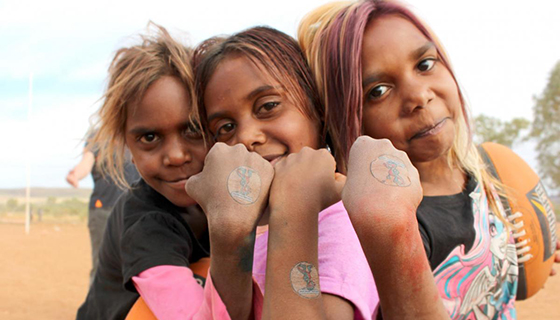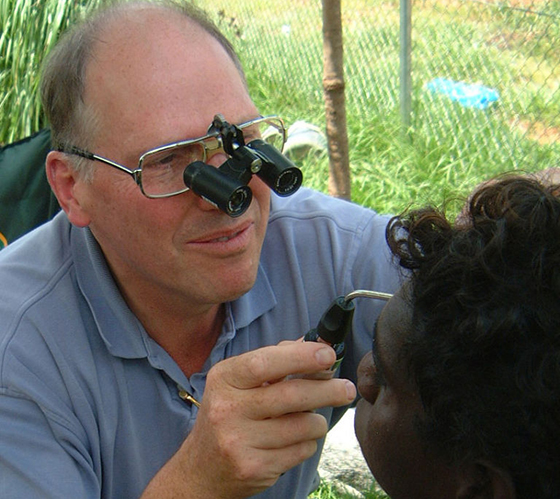Paul Ramsay Foundation helps close Indigenous vision gap
A critical investment in Indigenous health will help eliminate preventable blindness.
The Paul Ramsay Foundation will invest more than $1.5 million from now until 2020 in a move that ensures the University of Melbourne’s Indigenous Eye Health group (IEH) can help improve eye outcomes for Aboriginal and Torres Strait Islander Australians nationwide.
The IEH is based in the Melbourne School of Population and Global Health, where it has been working since 2008 to establish effective and sustainable eye care systems for Indigenous Australians. Initial philanthropic support allowed the IEH to develop its Roadmap to Close the Gap for Vision (2012), which aims to ensure equity in Indigenous eye care outcomes and eliminate trachoma from Indigenous communities.
Support Indigenous eye health today
Debilitating vision loss and blindness are still three times more prevalent amongst Indigenous Australians than the rest of the country. In 2008, vision loss was the equal third largest contributor to the health gap between Indigenous and non-Indigenous Australians. In 94 per cent of cases, the vision loss is either preventable or treatable, relying on relatively simple intervention such as regular eye checks, access to glasses and surgery and – in the case of trachoma – when basic washing facilities are made available and used.

Children from Ntaria in the Northern Territory show off temporary tattoos of ‘Milpa’ the trachoma goanna who is part of the education effort developed by Indigenous Eye Health at the University of Melbourne. Picture: Rachael Ferguson, IEH
The Roadmap comprises 42 integrated policy recommendations formulated by IEH, which is led by world-recognised ophthalmologist and Melbourne Laureate Professor Hugh Taylor AC, who is the Harold Mitchell Chair of Indigenous Eye Health at the University of Melbourne. Eleven of the recommendations have been fully implemented, while 62 per cent of all activities have been completed. All the recommendations feed into the prevention and treatment of vision loss caused by trachoma, refractive error, cataracts and diabetes.
Professor Taylor said the work being done supports Indigenous Australians across Australia in remote, regional and urban areas. He emphasised that the University’s role is to enable the expansion and improvement of critical health services, but is informed and driven through the trust and support of local communities.
“The University of Melbourne’s commitment to Indigenous eye health is visible and credible, and is focused on building long-term sustainable systems to ensure ongoing eye care,” he said.
“We work with State and Federal governments and local communities to reform approaches to eye care that remove the uncertainty, stress and confusion associated with many mainstream health services.”

Laureate Professor Hugh Taylor has devoted his career to researching and promoting eye health around the world and has been freed up by the University to work full time on helping to close the vision gap for Indigenous Australians. Picture: University of Melbourne
Professor Taylor said the Paul Ramsay Foundation’s support increases the speed and spread of regional activities, allowing the IEH to put systems in place to close the gap for vision by 2020.
“Our goal is to ensure Indigenous eye health outcomes match those of non-Indigenous Australians,” he said.
“Australia remains the only developed country where trachoma still exists, but with the collaborative efforts encouraged by the Roadmap and community-led health approaches, Australia is well on the way to eliminating this cause of unnecessary blindness.”
Since 2008 and supported by the Roadmap, trachoma has been eliminated from more than 150 communities, although residual “hotspots” exist and more work is needed to finish the job. Progress is further evidenced by increased eye examination rates. Fewer than 10 per cent of Indigenous adults report having had no previous eye exam, compared to over one third in 2008. The uptake of recommended annual eye checks for Indigenous people with diabetes has also increased from 20 per cent to 53 per cent.
While there is still much to address, Professor Taylor reiterated that demonstrable inroads have been made to address Indigenous eye health.
“In 2016 the gap in blindness for Indigenous Australians has been halved from being six times higher in 2008,” he said.
“Generous support of donors such as the Paul Ramsay Foundation has been fundamental in the development of these improved health outcomes, and we are immensely grateful for their support and their confidence in our work.”
Charlotte Siddle, Project Manager at the Paul Ramsay Foundation, reiterated her organisation’s pride in partnering with the IEH.
“The Paul Ramsay Foundation is keen to support initiatives that demonstrate a strong understanding of the systems in which they work,” she said.
“Professor Taylor and his team have spent the last ten years gathering evidence about Indigenous eye health and all of this work has informed the Roadmap’s development and its implementation across Australia.
“This partnership’s learnings will not only benefit eye health, but be applicable to initiatives across multiple sectors. Given our commitment to learning and transparency, it is extremely exciting to be part of the journey towards Closing the Gap for Vision.”
The Paul Ramsay Foundation’s support to the IEH contributes to the larger Believe – the Campaign for the University of Melbourne, which helps fund life-changing research, gives bright students the chance to excel and funds projects that improve communities worldwide